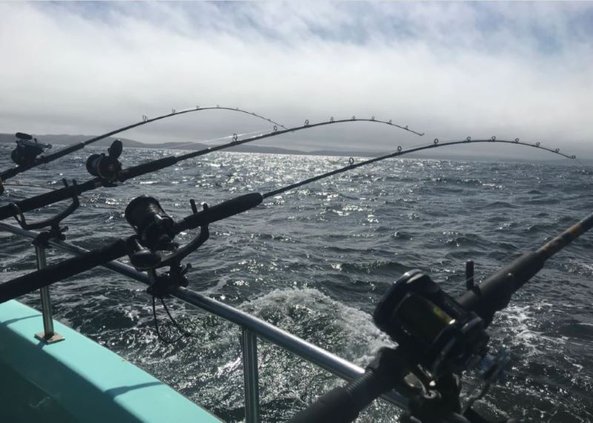Trading sport-caught fish
Q: If I catch bluefin tuna on a charter boat, can I trade it for fishing gear?
A: No. It is not legal to trade sport-caught fish for fishing gear. California Fish and Game Code (FGC) section 7121 prohibits selling or purchasing sport-caught fish – and the definition of “sell” includes barter, exchange or trade (FGC, section 75).
Urban coyotes
Q: What’s the best way to haze urban coyotes?
A: Hazing is a process designed to scare animals away and instill in them a fear of humans, which is done for both public safety and the well-being of the animal. For the general public, here are a few hazing techniques that can work with coyotes: Making yourself look as big and scary as possible, waving your arms above your head, vocalizing aggressively toward the coyote while maintaining eye contact, stomping your feet and taking a few steps in the coyote’s direction (while maintaining a safe distance), throwing rocks or sticks toward the coyote, using a shaker can (a can filled with coins or some other small object that when shaken makes a loud noise), using a garbage bag by shaking it open so it makes noise, or using an airhorn or water gun.
For hazing to be effective, people need to continue to haze the coyote until it completely leaves the area. Many people will haze the coyote and then stop once the coyote takes a few steps away. However, it’s crucial to continue hazing until the coyote completely leaves the area.
More information about living with urban coyotes can be found on California Department of Fish and Wildlife’s (CDFW) Keep Me Wild web page. Additionally, CDFW’s Wildlife Watch Program produced a document on coyote hazing techniques. People who are experiencing problems with urban coyotes are encouraged to submit a Wildlife Incident Report. CDFW also helped produce a short video about living with coyotes.
CDFW’s goal is to help people and wildlife coexist, and that includes native predators like coyotes. Coyotes occupy an extremely important niche in our ecosystem. They help keep rodents under control and scavenge carrion (remains of dead animals), which helps keep neighborhoods clean.
Remember that hazing must always be done safely and from a distance. If there is an immediate danger to public safety, or if a coyote has bitten or scratched a human, get to a safe location and call 911.
Crab loop traps
Q: Can two crab loop traps be used simultaneously on one fishing pole?
A: Yes. It is legal to have two crab loop traps used simultaneously on one fishing pole. However, if you’re on a public pier, no person shall use more than two rods and lines, two hand lines, or two nets, traps or other appliances used to take crabs, per California Code of Regulations (CCR), Title 14, section 28.65(b). Also see CCR, Title 14, section 29.80 which covers gear restrictions for recreational take of saltwater crustaceans. A hook is not a legal method of take for crabs. If you’re going to use crab loop traps, you’ll need to tie the trap onto the line instead of using a hook. Bottom line: While fishing for crabs from a public pier in ocean waters, you can either have two poles with one loop trap tied on each, or one pole with two loop traps.
If you have a question you would like to see answered in the California Outdoors Q and A column, email it to CalOutdoors@wildlife.ca.gov.





